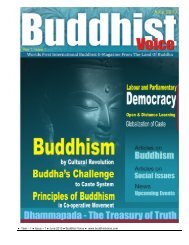BV - May 2015 Yr 2 Issue 6 E
Create successful ePaper yourself
Turn your PDF publications into a flip-book with our unique Google optimized e-Paper software.
conservative estimate was half a million<br />
people, who poured down from all directions<br />
with whatever conveyances they could get.<br />
Many walked down with meals packed for<br />
three days, dried pieces of homemade jaur<br />
bread and an onion or two’.<br />
He was the leader of a group of students that<br />
met Dr Ambedkar and was also invited at the<br />
tea party at Shyam Hotel in the evening.<br />
There are hundreds of aspects of Dr<br />
Ambedkar’s life, which are unknown or may<br />
be ignored by many but K. Jamnadasji<br />
brought all those facets through his<br />
anecdotes. It was interesting to hear from<br />
him how Babasaheb Ambedkar was trying to<br />
do. His narratives of the tea party in the<br />
evening of Dhammachakra Pravartan Diwas<br />
provide deep thought on which Babasaheb<br />
Ambedkar was focusing.<br />
‘I had heard Babasaheb on many occasions<br />
before, but that was the first time, I was<br />
hearing him talk in fluent Hindi. The speech,<br />
though brief, had many new points, and very<br />
scanty reports of this speech are available.<br />
He said that we all cared more for politics<br />
than social and religious change. He had<br />
achieved everything in his life for himself.<br />
There was nothing more to be achieved for<br />
himself, “except perhaps the post of Prime<br />
Minister”, among cheers, he declared. But he<br />
was worried for all of us, as we keep on<br />
fighting amongst ourselves. He said, we were<br />
not used to work with people of other castes.<br />
Though the “Scheduled Castes Federation”<br />
(SCF) would be in existence for some more<br />
time and though Buddhists, we could still be<br />
members of it, as he had already made<br />
provisions in Constitution of SCF for<br />
“sympathizers”, it was time we change our<br />
ways and start learning to work together with<br />
other castes. He was already in touch with<br />
other leaders like R. M. Lohia, N. G. Gore,<br />
Madhu Limaye, P. K. Atre, S. M. Joshi and<br />
others and he had prepared the Constitution<br />
of new party, which would be launched soon.<br />
He gave a lot of stress on mixing with the<br />
people of democratic thoughts, belonging to<br />
other castes. It is rather unfortunate, that<br />
this aspect of his speech is totally neglected<br />
by the next generation of leaders, our<br />
predecessors. When next year in 1957,<br />
Republican Party of India was formed, there<br />
was not one single member of other castes’.<br />
Most of the us world over know about the<br />
Nagpur conversion ceremony but I was<br />
amazed to hear from Dr K. Jamanadas that<br />
the Chandrapur mass conversion on October<br />
16 th , 1956, was equally big and had huge<br />
crowed waiting for Babasaheb. It is great that<br />
he has recorded all these events which give<br />
us ideas of how people have so much faith in<br />
Dr Ambedkar due to his idealism, conviction<br />
and commitment for the cause of the society.<br />
The impact of conversion was wider though it<br />
remained confined to Mahars in Maharashtra<br />
yet they discarded Hindu festivities and<br />
symbols. Hundreds of women threw away<br />
their ‘Mangalsutras’ once they were informed<br />
that it is the symbol of slavery of a woman<br />
and against the principles of Buddhism.<br />
Dr K Jamanadas was a devoted Ambedkarite<br />
who lived every day according to principles of<br />
Ambedkarism and Buddhism. The women<br />
question was very important to him and he<br />
felt that Ambedkarites were not doing enough<br />
in that direction. He felt that joint family<br />
system was destructive and governed by<br />
Mitakshara Law, which is in force in<br />
practically whole of India. According to him,<br />
Dr. Ambedkar wanted that the Dayabhag<br />
Law should replace it. This is not achieved<br />
yet. Unfortunately, the Ambedkarites are not<br />
fighting for the demand of introduction of<br />
Dayabhag Law all over the country. They<br />
have not yet realized that this one single<br />
measure would give a strong blow to the<br />
caste system.<br />
He explained the differences between<br />
Mitakshara and Dayabhag laws so that<br />
Ambedkarite could fight for the latter.<br />
‘While stating that the main difference after<br />
Hindu Code would be ‘the abolition of the<br />
right by birth and the principle of<br />
survivorship and the substitution of the<br />
Dayabhag for Mitakshara in the Mitakshara<br />
Provinces, Dr. Ambedkar, in his speech on<br />
Hindu code, explained the fundamental<br />
differences between two systems of<br />
inheritance in Mitakshara and Dayabhag<br />
Law. According to Mitakshara, the property of<br />
a Hindu is not his individual property. It is<br />
property, which belongs to what is called a<br />
coparcenary, which consists of father, son,<br />
grandson and great grandson (the ‘sapinda-s’<br />
). All these people have a birthright in that<br />
property and the property on the death of any<br />
member of this coparcenary passes by<br />
survivorship to the members who remain<br />
behind, and does not pass to the heirs of the<br />
deceased.<br />
‘The Bill, while it does away with coparcenary’, Dr.<br />
Ambedkar said, ‘maintains the joint family’. He<br />
further clarified that, ‘The only distinction will be<br />
that the members of the joints family instead of<br />
holding their rights as joint tenant will hold them<br />
as tenants in common’.<br />
● Year – 2 ● <strong>Issue</strong> – 6 ● <strong>May</strong> <strong>2015</strong> ● Buddhist Voice ● www.buddhistvoice.com ● Email: indian.buddhistvoice@gmail.com 42



